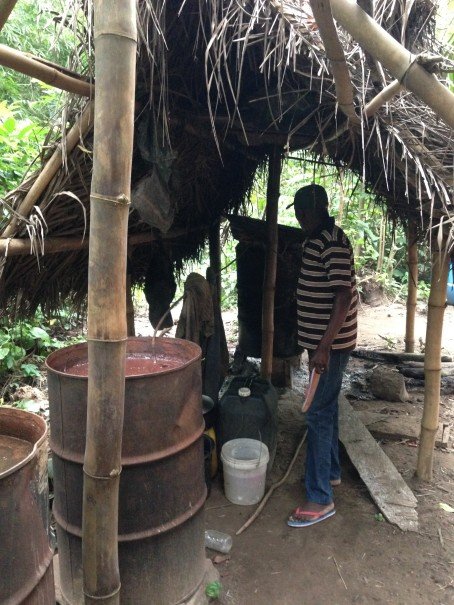
Nothing Starts a Party Like Liquor Without a Standardized Alcohol Content

Nothing Starts a Party Like Liquor Without a Standardized Alcohol Content
Akpeteshie in Ghana
We could say with certainty that it was better than the gin sachets. We bought the clear liquor by the half-bottle, or by the bottle when we were feeling ambitious, from a shack in the alley behind Osu’s biggest supermarket. Sometimes they didn’t have it on hand, and the bartender sent the waitress hurrying down the rutted street to buy it from someone else. Sometimes we got it in clear, cheap bottles, the label scratched off; other times, in ornate, square green bottles. Sometimes we drank it during “dumsor,” Ghana’s increasingly frequent power cuts, sitting at blue plastic tables in the alley behind the supermarket in the dark while the generators thundered around us.
We were all in our 20s, recent and less-recent American college grads with grand aspirations who had all been, in some way, shaken into awareness of the futility of our various Ghanaian endeavors. So we drank akpeteshie. Sometimes, we were barely tipsy; sometimes, we barely managed to stumble our way home. It always burned going down.
Akpeteshie is the local gin, distilled from palm wine, usually in rusted barrels in the middle of the forest. The drink was dubbed “akpeteshie,” meaning “in hiding,” during British rule in the 1930s, when the colonial government banned the production and sale of locally-brewed alcohol, in part to curb drinking habits, but in larger part to favor their own alcoholic imports. Today, the gin is still often produced in hiding, distilled in the forest close to palm wine plantations. The clear alcohol drips into a plastic bucket or jerry can, and is usually bottled into recycled liquor bottles and sold throughout Ghana.
Traditionally consumed by fishermen and farmers, or in small doses at rural ceremonies, the potent liquor is finding a new audience among Accra locals and penny-pinching expats in search of a fun night. In some bars, bartenders mixed us drinks with sweet hibiscus and passion fruit and their own carefully distilled akpeteshie. But others still sold the more or less fiery, forest-brewed akpeteshie to whoever was crazy enough to stop in to buy a recycled half-bottle.
It wasn’t until I visited a distillery, hidden among the palm trees near a waterfall in the Volta Region, that I understood what went into those recycled bottles. Four copper barrels rusted underneath a palm-frond hut; green muck and algae floated inside the barrels in tranquility. Below the furthest barrel, chunks of charred wood simmered and crumbled into ash; above it, the freshly collected palm wine was heated until it vaporized.The vapor was piped around the copper barrels too cool it. It didn’t pass through the goop that was inside.
This was a minor comfort, though. Facing those rusted barrels, with no standardized way to regulate the production of the liquor, no metrics or measurements, I realized why some nights, a single shot did me in, and other nights, I could go on for hours.
Sitting in the dark at our usual spot a few nights later, we drank to send off a friend. The akpeteshie burned in my chest, a fierce punch. I was going home in a few weeks, leaving the heat and the dark nights. At home, I knew the effects of one shot of gin. But with the fiery akpeteshie settling and the first hint of lightheadedness swirling, I realized that I dreaded that certainty. I prefer the mismatched bottles, the wildly varying alcohol content, the murky waters.